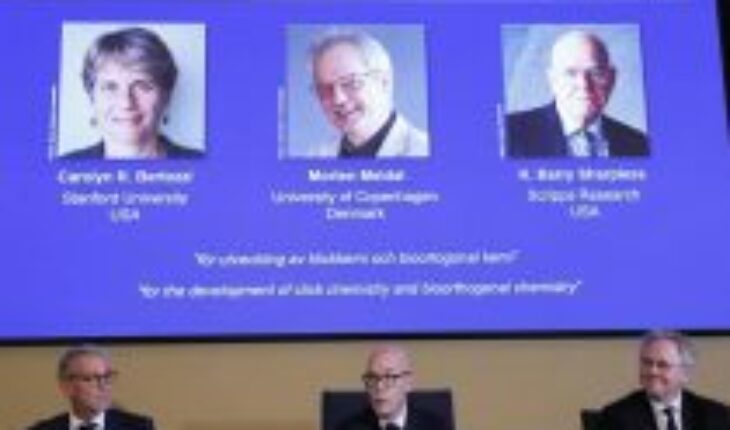Scientists Carolyn Bertozzi, Morten Meldal and K.Barry Sharpless are the winners of the Nobel Prize in Chemistry for the development of click chemistry, which has made it possible to improve the orientation of pharmaceuticals against cancer, the Swedish Academy of Sciences in Stockholm announced.
This year’s Nobel prize rewards “the development of click chemistry and bioorthogonal chemistry,” said the academy, which said that with their work the winners have contributed to improving anti-cancer drugs.
The work of this year’s laureates “pushes the boundaries (of chemistry) and has a great impact on science and society.”
“Click chemistry is used in the development of pharmaceuticals, to map DNA and create materials that are more fit for purpose. Using bioorthogonal reactions, researchers have improved the targeting of pharmaceuticals against cancer,” the Swedish academy said.
The award rewards, the academy added, works that try “to make difficult processes easier. Click chemistry and bioorthogonal reactions have brought chemistry into the era of functionalism.”
This year’s winners “have laid the groundwork for a functional form of chemistry, click chemistry, in which molecular building blocks come together quickly and efficiently.”
Bertozzi, in particular, “has taken click chemistry to a new dimension and started using it in living organisms. Their bioortogonal reactions take place without altering the normal chemistry of the cell.”
The Swedish academy recalled that “for a long time, chemists have been driven by the desire to build increasingly complicated molecules. In pharmaceutical research, this has often involved the artificial recreation of natural molecules with medicinal properties.”
This has resulted in many admirable molecular constructs, but they are generally time-consuming and very expensive to produce, the academy added in the statement released in releasing the names of the laureates.
Sharpless, who is now receiving his second Nobel Prize in Chemistry, began “to roll the ball,” the Academy graphically estimated by recalling that around a year he coined the concept of click chemistry, which is a simple and reliable form of chemistry, where reactions occur quickly and unwanted byproducts are avoided.
Soon after, Meldal and Sharpless, independently of each other, presented what is now the crown jewel of click chemistry: the copper-catalyzed azide-alkyne cycloaddition.
“This is an elegant and efficient chemical reaction that is now in widespread use. Among many other uses, it is used in the development of pharmaceuticals, to map DNA and create materials that are more suitable for their purpose,” the Academy explained.
Bertozzi took click chemistry to a new level. To map important but elusive biomolecules on the surface of cells (glycans), he developed click reactions that work within living organisms. Their bioorthogonal reactions take place without altering the normal chemistry of the cell, the institution’s officials added.
“This year’s Chemistry Prize is about not overcomplicating things, but about working with the easy and simple. Functional molecules can be built even by following a direct route,” said Johan Åqvist, chairman of the Nobel Committee on Chemistry.
Today’s prize is the last among the scientific awards of the Nobel round, after having been revealed on Monday that of Medicine and yesterday, Tuesday, that of Physics. The announcements will continue on Thursday with the Literature, on Friday the Peace will be known and next Monday the Economy.
Follow us on





